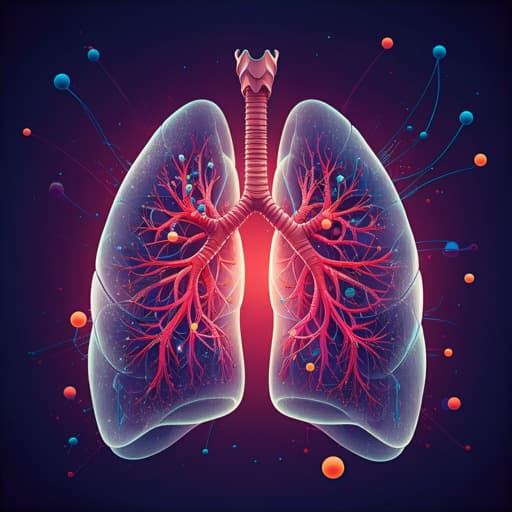
Medicine and Health
Detecting COVID-19 From Lung Computed Tomography Images: A Swarm Optimized Artificial Neural Network Approach
S. Punitha, T. Stephan, et al.
This groundbreaking research introduces a Computer Aided Diagnosis (CAD) system for COVID-19 detection, leveraging an Artificial Bee Colony (ABC) optimized Artificial Neural Network (ABCNN). The method accurately classifies lung CT images as COVID-19 or non-COVID-19 with an impressive accuracy of 92.37%. Conducted by esteemed authors S Punitha, Thompson Stephan, Ramani Kannan, MUFTI Mahmud, M Shamim Kaiser, and SAMIR Brahim Belhaouari, this study pushes the boundaries of medical image analysis.
~3 min • Beginner • English
Introduction
The study addresses the need for reliable, early, and accurate diagnosis of COVID-19 from medical imaging, given the disease’s rapid spread, high mortality in vulnerable populations, and challenges in laboratory testing. Chest CT imaging can reveal pneumonia-related abnormalities associated with COVID-19, but manual assessment is time-consuming and subjective. The authors propose leveraging artificial intelligence, specifically artificial neural networks (ANNs) optimized via swarm intelligence (Artificial Bee Colony, ABC), to automate segmentation and classification of COVID-19-related lesions in CT scans. The research aims to improve diagnostic accuracy while reducing network complexity by jointly optimizing image segmentation thresholds, input feature selection, and ANN parameters (initial weights and hidden nodes), thereby overcoming limitations of manual diagnosis and suboptimal ANN design.
Literature Review
The paper reviews AI/ML methods applied to COVID-19 diagnosis from CT and X-ray images. Highlighted works include: adaptive feature selection for CT-based COVID-19 analysis achieving 91.79% accuracy (Sun et al.); CNN with XGBoost classification on 708 CT images achieving 95.07% accuracy (Carvalho et al.); noise-robust COVID-19 lesion segmentation (COPLE-Net) trained on 558 CT images (Wang et al.); weakly supervised 3D CT classification/localization using DeCoVNet with rapid inference (Wang et al.); ensemble and voting-based classifiers combining optimization algorithms (El-Sayed et al.); deep learning ensembles and model fusion for X-ray classification achieving up to 99.01% accuracy (Rajaraman et al.); multi-objective differential evolution optimized CNNs for CT binary COVID-19 classification (Singh et al.); deep network plus GLCM with random forest on 2482 CT images (Goel et al.); and additional deep learning systems for CT/X-ray screening and lesion segmentation. These studies demonstrate the effectiveness of deep learning and optimization for feature selection, segmentation, and classification but often require large annotated datasets or focus on isolated components (either segmentation or classification). The authors position their contribution as a wrapper-based approach that simultaneously optimizes segmentation thresholds, feature subsets, and ANN parameters using ABC.
Methodology
Dataset and split: A total of 470 lung CT images (275 COVID-19, 195 non-COVID-19) from a public dataset [67] were used. Data were split into 50% training, 25% validation, and 25% testing.
Pipeline overview: The ABCNN system includes preprocessing, region of interest (ROI) extraction, ABC-optimized region growing segmentation of infected regions, feature extraction, ABC-based feature selection and ANN parameter optimization, and final classification.
Preprocessing: Noise reduction via Wiener filtering, preserving edges and fine details. Filtered images are used for subsequent processing.
Lung region extraction: Global histogram-based thresholding segments lung regions from CT images using a threshold T such that pixels with intensity above T are labeled lung; remaining pixels are background. Binary and gray-level lung masks are produced for downstream steps.
Infected region segmentation (ROI): For images classified as abnormal, infected regions are segmented using a region-growing method whose seed/threshold is dynamically optimized by ABC. Steps: (1) Input segmented lung region; (2) ABC generates optimized threshold α (seed); (3) Add 4-neighborhood; (4) Grow region by comparing neighbor mean intensity to current region mean; (5–8) Iterate until similar pixels are grouped. Since infection intensities vary, a dynamic threshold is needed; ABC is used to search optimal thresholds.
ABC for threshold optimization: Representation: food sources encode candidate thresholds. Initialization samples thresholds within bounds using E_lk = E_lk + rand*(E_lmax − E_lmin). Fitness evaluates segmentation by comparing the algorithm’s binary mask to manual ground truth via pixel-wise agreement (unequal pixels counted by XOR, then subtracted from image size). Employed bees explore neighborhoods V_lk = E_lk + rand*(E_lk − E_lv); onlookers select based on probability proportional to fitness; best food source is memorized; scouts replace stagnated sources.
Feature extraction: From segmented infectious regions, intensity histogram features and second-order texture features are extracted using gray-level co-occurrence matrix (GLCM) and gray-level run-length matrix (GLRLM). The initial feature set size is 20.
ABC-driven feature selection and ANN design optimization: A wrapper approach simultaneously selects input features (bitmask), initializes ANN weights, and selects hidden node count. Solution encoding: A bits encode initial weights (A=15 bits), B bits encode hidden nodes (B=2 bits), C bits encode feature selection (C=20 bits), D bits encode segmentation thresholds. Decoding applies selected features across train/validation/test, sets ANN initial weights and hidden node size.
ANN training and fitness: A multilayer perceptron (MLP) with two output nodes (COVID vs non-COVID) is trained using backpropagation variants: Resilient Propagation (RP), Levenberg–Marquardt (LM), and Gradient Descent (GD). Early stopping monitors validation error; training halts if validation error increases for six consecutive iterations. ANN error (NNerror) is computed over validation outputs; fitness is 1/NNerror. ABC operators (employed/onlooker/scout) search the joint space of features, initial weights, and hidden nodes to maximize ANN fitness.
Complexity metric: Network complexity is measured by number of connections: Con = O*P + P*Q + P + Q, where O = input features, P = hidden nodes, Q = output nodes (Q=2).
Implementation details: MATLAB R2019a on Intel i5 8th Gen, 8 GB RAM, Windows 10. Neural Network Toolbox used. Winner-takes-all classification at output. ANN parameters: input feature size 20; outputs 2. ABC parameters: 30 bees (employees = onlookers), max iterations 30, independent runs 10; results reported as mean over runs. Segmentation evaluation uses DICE and Jaccard similarity against manual masks.
Key Findings
- Dataset and setup: 470 CT images (275 COVID-19, 195 non-COVID-19), split 50/25/25 for train/validation/test. Ten independent runs evaluated across generation sizes 10, 20, and 30.
- Best overall accuracy: ABCNN with Resilient Propagation (ABCNN-RP) achieved 92.37% mean classification accuracy at generation size 20 (ten runs).
- Comparators (same framework, different backprop): ABCNN-GD reached 89.83% at generation 30; ABCNN-LM reached 90.67% at generation 30. ABCNN-RP exceeded ABCNN-GD by 2.83% and ABCNN-LM by 1.87%.
- Model complexity: ABCNN-RP yielded the fewest connections on average (17.25 at generation 20). Complexity was 9.35% lower than ABCNN-GD and 14.65% lower than ABCNN-LM. The minimum observed connections for ABCNN-RP was 15, which is 11.76% fewer than GD and 16.67% fewer than LM.
- Feature selection impact: ABCNN with optimized feature subsets (FS) improved accuracy while reducing network complexity compared to using all features.
- Segmentation: Infected region segmentation was evaluated using DICE and Jaccard similarity against manual annotations, with qualitative examples showing close agreement between auto- and manually segmented regions.
- Computational time: Among backprop variants, ABCNN-LM required less computational time compared to the others reported.
- Comparison with other swarm optimizers (on the same data, 10/20/30 generations, best accuracy taken): ABCNN outperformed BA, BFO, ACO, DA, and PSO by 3.24%, 2.9%, 6.82%, 8.45%, and 2.1%, respectively.
- Comparison with conventional classifiers (same dataset, with ABC-based segmentation thresholding and feature selection but without per-classifier parameter optimization): ABCNN accuracy exceeded SVM by 4.41%, Naive Bayes by 7.94%, Random Forest by 8.83%, and Decision Tree by 5.96%.
Discussion
The results demonstrate that jointly optimizing segmentation thresholds, feature subsets, and ANN parameters via the Artificial Bee Colony algorithm yields a more accurate and compact classifier for COVID-19 detection in CT images. Dynamic, ABC-optimized region growing improves infected region segmentation, providing higher-quality ROIs for feature extraction. The wrapper-based feature selection identifies informative texture and intensity descriptors, reducing input dimensionality and helping to avoid overfitting. ABC-guided initialization and hidden-node selection enhance training convergence and generalization, particularly when combined with Resilient Propagation, which achieved the highest accuracy and lowest complexity among tested backprop variants. Comparative analyses show ABCNN’s superiority over other swarm optimizers and baseline classifiers on the same dataset, indicating that ABC’s global-local search balance is well-suited for the coupled segmentation-classification optimization. Overall, the approach addresses the research goal of accurate, automated COVID-19 CT diagnosis while constraining network complexity.
Conclusion
The paper presents ABCNN, a computer-aided diagnosis framework that integrates ABC-optimized region growing for lesion segmentation with ABC-driven feature selection and ANN architecture optimization for COVID-19 detection from lung CT images. Evaluated on 470 CT images, ABCNN—particularly with RP training—achieved a mean accuracy of 92.37% with reduced network complexity, outperforming other swarm optimizers and standard classifiers. The wrapper-based joint optimization simplifies the design of the ANN and improves both segmentation quality and classification performance. Future work includes applying the framework to larger, high-dimensional datasets and integrating deep learning models within cloud-based e-Healthcare/IoMT environments to further enhance scalability and clinical utility.
Limitations
The authors note that the computational complexity of the optimization-driven framework can be higher than non-optimized models. The evaluation was conducted on a single publicly available CT dataset and focused on binary classification (COVID-19 vs non-COVID-19), which may limit immediate generalizability without further multi-center validation and broader class coverage.
Related Publications
Explore these studies to deepen your understanding of the subject.







